Smiles are one of the most important assets of an individual, both in personal as well as professional life. One of the major factors influencing this winning smile is, of course, the effectiveness of brushing our teeth.
There are a number of oral hygiene products in the market and it becomes arduous for the people to ascertain which is more beneficial to their teeth. Tooth brush and toothpaste are among the most commonly used home care products to maintain oral hygiene. Most people’s choice of toothpaste is based on taste or cost and not on the oral benefit it provides. Some of the factors which influence the choice of toothpaste from the customer’s point of view are perceived performance, brand awareness, product attribute, taste, credibility of the company, availability of product information and herbal ingredients [1].
This study evaluates the factors which influences the awareness and practice of oral hygiene among the general population of Maduravoyal, Chennai, India.
Materials and Methods
A cross-sectional questionnaire based study was conducted for a period of 8 months (March 2014-September 2014) to understand the factors influencing the choice and practice of oral hygiene products among the population of Maduravoyal, Chennai, India. Data was collected by means of a self administered structured questionnaire written in English and validated through a pilot survey. The questionnaire contained 9 multiple choice questions related to the oral hygiene method used to clean the teeth, the type of dentifrice used, frequency of brushing, brand of tooth paste/powder used, duration of using that particular brand of tooth paste/powder, amount of tooth paste dispensed on the brush, satisfactory level with the use of current tooth paste/powder, reason for choosing that particular brand of tooth paste/powder. Among the 9 questions, 7 were close ended and 2 were open ended.
One thousand two hundred and twenty subjects, with an age range of 15 to 70 years, who visited the Department of Periodontology, Meenakshi Ammal Dental College, Chennai between March 2014 and September 2014 were recruited for the study. Out of these, 11 subjects were not willing to participate, hence excluded from the study. One thousand two hundred and nine subjects, who were willing to be the part of the study, were selected for investigation. The study was explained to all the selected participants and the consent was obtained from them. The self administered questionnaire which was validated through the pilot study was distributed among the subjects. Each participant was asked to respond to each item according to the response format provided in the questionnaire. The participants received a full explanation of how to fill in the questionnaire and were assisted by the investigator to do so if uneducated. The selected subjects actively responded to the questionnaire. Anonymity of the respondents was assured.
Results
In our study, out of 1209 subjects, 60.7% were males and 39.3% were females [Table/Fig-1]. 98.5% of the total population used tooth brush for cleaning their teeth and 1.5% of them used fingers [Table/Fig-2]. Nearly 84.6% of the total subjects brushed once daily; 15.2% brushed twice daily and 0.2% brushed thrice daily [Table/Fig-3]. Almost, 98% of them used tooth paste and 2% of the subjects used tooth powder to clean their teeth [Table/Fig-4]. Ninety eight percent of the total subjects were using various over the counter tooth pastes; 58.3% of the subjects used Colgate, 18.4% used Pepsodent, 8.5% used Close up and 4.7% used therapeutic paste like Sensoform, Sensodyne and Stolin. 59.1% of the total population chose their tooth paste from advertisements; 31.5% of them chose the tooth paste recommended by others and 9.3% of them chose the tooth paste recommended by dentist/health professional [Table/Fig-5]. Among the subjects who chose tooth paste based on advertisements in media; 4.8%, 26.5%, 17.04% and 11.7% used them for 6 months, 1-5 years, 5-10 years and 10 years respectively. Among the subjects who chose the tooth paste recommended by others, 2.48%, 15.55%, 8.52%, 4.96% used for 6 months, 1-5 years, 5-10 years, 10 years respectively. Among the subjects who chose the tooth paste recommended by dental professional; 1.57%, 4.22%, 2.73%, 5% of them used it for 6months, 1-5 years, 5-10 years; and more than 10 years respectively [Table/Fig-6].
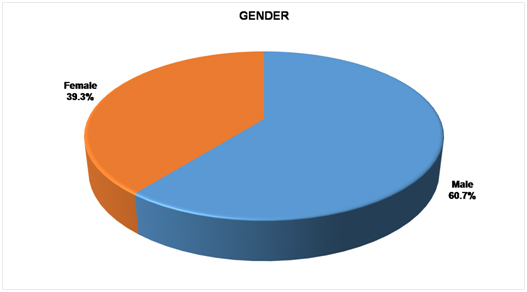
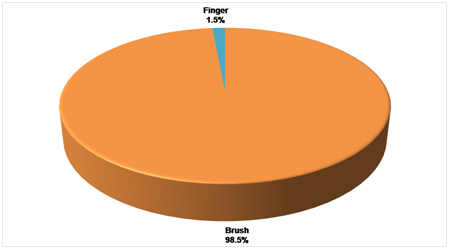
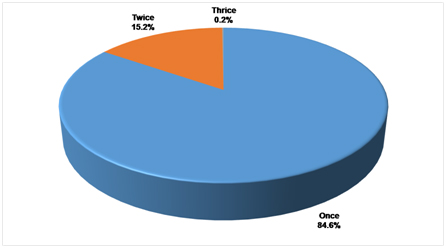
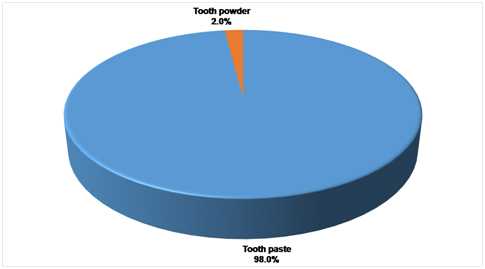
Toothpaste preference based on recommendation
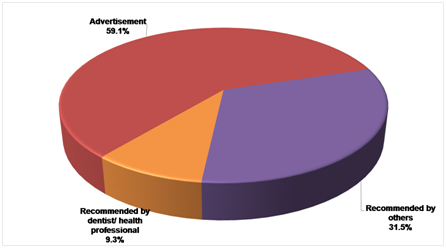
Duration of toothpaste usage in percentage
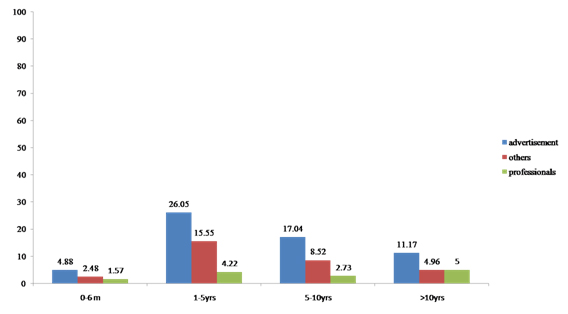
While considering the amount of tooth paste dispensed on the tooth brush head, 51% of the total subjects dispensed tooth paste to the full length and 49% of them dispensed pea sized amount [Table/Fig-7]. The study revealed that 51% of them were fully satisfied with their tooth paste and 49% of them were somewhat satisfied [Table/Fig-8]. Moreover, 49.7% of the entire population preferred decay prevention; 34.7% preferred gum care; 31.7% preferred taste/flavour; 30.2% preferred teeth whitening; 23.7% preferred colour and appearance; 22.7% preferred desensitizing property of tooth paste and 7.9% of them preferred the cost of the tooth paste [Table/Fig-9].
Amount of toothpaste dispensed
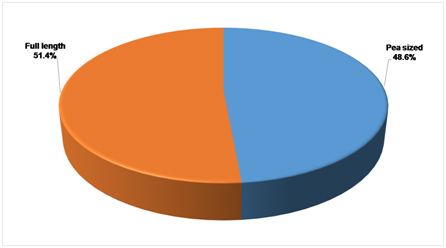
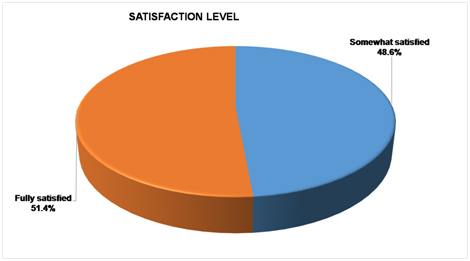
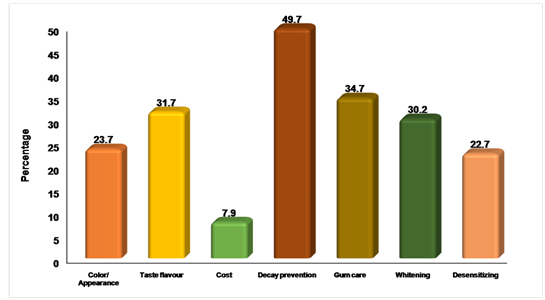
Discussion
Most of the people in India use a variety of commercially available and natural oral hygiene products such as toothpaste and powder. However, the awareness about the beneficial effects of these products is less among the Indian population, since the population is influenced by other factors such as taste, colour, advertisement and celebrity endorsement. Hence, this survey was focused on the factors that influence choice of the tooth paste among the local population in Chennai.
Out of 1209 subjects, 60.7% were males and 39.3% were females, which revealed less female participants as compared to males. This is in accordance with the study done by Archana et al., [2]. In urban population the toothbrush and tooth paste are the most commonly used products of oral hygiene. Out of the 1209 subjects, 98.5% of the subjects used toothbrush to clean their teeth, which is in accordance with the study done by Dilip et al., Pankaj et al., [3,4].
In the present study, 84.6% brushed once daily in the morning and 15.2% of the subjects brushed twice a day. This is inconsistent with the percentage of people brushing at least twice daily (22%) which is in accordance with the study done by Archana et al., [2]. However, in our study, the percentage of subjects brushing twice daily was lower compared to 58% in a study by Dilip et al.,, 67% by Jiang et al.,, 20% by Pankaj et al., in Anganwadi workers and 62% in a study by Al-Shammari et al., in Kuwaiti adults [3–6]. Kressin et al., evaluated the effect of oral hygiene practices on tooth retention in a longitudinal study with a 26-year follow up [7]. They observed that consistent brushing (more than once a day) resulted in 49% reduction of risk of tooth loss compared with participants without consistent oral hygiene habits. Echeverria et al., also recommended to brush twice daily [8]. In our study, 51.4% subjects were fully satisfied with the current tooth paste used and 48.4% were not fully satisfied with the current toothpaste. To our knowledge, this is the only study measuring the satisfactory level of the tooth paste used by the participants.
In the present study, majority of them (98%) used tooth paste. 48.6% of the subjects used pea sized amount of toothpaste and 51.4% of them used tooth paste to the full length of the tooth brush head. To provide optimal fluoride effectiveness against caries and to minimize the risk of negative effects from excessive ingestion from tooth brushing, it is particularly important for young children to use a ‘pea-sized amount’. However, there appears little guidance regarding what this means in practice, although it has been indicated to be 0.25 g [9].
59.1% of them started using particular brand of toothpaste based on advertisements on television and radio channels. Only 9.3% of them used toothpaste recommended by dentist/health professional. In a survey done by Vani et al., 200 respondents were included, in which, 45% of them were attracted to toothpaste based on advertisements [10]. In a survey done by Archana et al., among the local population of Udaipur, 39.6% of them selected their tooth paste by getting information from the media, whereas in the study done by Dilip et al., magazines, television and radio were the major sources of information for preference of tooth paste [2,3]. Advertisements and celebrity endorsements create attention and stimulate individual’s preference for a tooth paste. In contrary, there were less percentage of people choosing their toothpaste by the advice of the dental professionals (9.3%) in the present study, which was in accordance with the study done by Archana et al., and Dilip et al., [2,3].
The expectations from toothpaste varied among the respondents. Majority of them (49.7%) preferred the decay prevention property of the toothpaste. This was in accordance with the study done by Vani et al., who discussed the benefit of toothpaste and buying the tooth paste based on its decay preventing property [10]. 34.7% of the respondents preferred gum care; 31.7% of the respondents preferred taste, flavour; 30.2% of them preferred teeth whitening; 23.7% of them preferred colour/appearance of the toothpaste; 22.7% of them preferred the desensitizing property of toothpaste and 7.9% of them preferred the low cost of toothpaste.
Majority of people were influenced by the advertisement and celebrity endorsement in choosing their oral hygiene products. Hence there is a need for the dental professionals to be aware of the ever-increasing development and marketing of dentifrices from various databases, which publish systematic reviews of randomized controlled clinical trials involving toothpastes. Clinicians should take an interest to advise their patients regarding oral hygiene products with the knowledge derived from such reviews which are based on a rigorous process of appraisal.
Conclusion
The present study has thrown some light on the awareness and practice of the tooth paste in a small semi-urban population and the influence of extraneous factors in choosing their tooth paste. Hence, Dental professionals should spare more time to educate and motivate the patients about the oral hygiene practices and the products. As proper oral hygiene and proper usage of oral health products will go a long way in reducing the incidence of dental diseases.